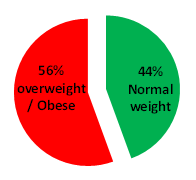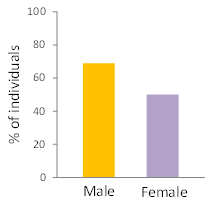
Cardiovascular Diseases in Young Asian Indians
Globally, cardiovascular diseases (CVD) are the main cause of disability and death. Indians living in India and around the world have a high prevalence of CVD. The occurrence of heart diseases, high blood pressure (hypertension), obesity and diabetes is increasing at a rapid pace amongst Asian Indians. These diseases are higher in the urban population and are no more considered to affect only the aged.
India has a huge youth population and by 2020, it is expected that India will become the youngest country in the world with 64% of its population in the working age group. This is good news. However, the worrying part is that half of the CVD-related deaths (52% of CVDs) in India occur below the age of 50 years. Asian Indians have a greater prevalence of hypertension at an earlier age. About 25% of heart attack incidences in India occur under the age of 40 years. These findings raise a major concern as it may affect the productivity of young Indians. This issue needs to be addressed and resolved, if we want a healthy India with healthy young Indians.
A majority of Asian Indians living abroad fall in the working age group (20 - 65 years). Many of them experience stress related to their work or environment, consume high-calorie foods/ drinks and hardly undertake any exercise. In Australia, prevalence of obesity amongst Asian Indians was reported to be around 61%. The prevalence of diabetes in the South Asian population living in the U.K. is nearly five-fold higher than in the indigenous white population. In US, diabetes in Asian Indians was nearly twice as high as in other Asian groups. The increase in cardiovascular related diseases (also known as modern day diseases) in Asian Indians has occurred within a relatively short period. This suggests that environmental (including food habits) and behavioral changes (sedentary lifestyle) may play a greater role than gene frequencies in influencing change in disease rates.
Our own data suggest that 56% of educated and well-off Asian Indians in the working age group is overweight to obese.

India has a huge youth population and by 2020, it is expected that India will become the youngest country in the world with 64% of its population in the working age group. This is good news. However, the worrying part is that half of the CVD-related deaths (52% of CVDs) in India occur below the age of 50 years. Asian Indians have a greater prevalence of hypertension at an earlier age. About 25% of heart attack incidences in India occur under the age of 40 years. These findings raise a major concern as it may affect the productivity of young Indians. This issue needs to be addressed and resolved, if we want a healthy India with healthy young Indians.
Every 2nd educated and well-off Asian Indian is Overweight
This data was obtained from individuals within the working age group who attended WYOP seminar in Delhi, India and Zurich, Switzerland.
45 individuals agreed to fill the questionnaire.Amongst the Asian Indians based in Zurich, Switzerland we report that 67% males and 40% females have a body mass index (BMI) which falls in the overweight to obese category.
Overweight and obesity is measured by calculating the BMI (Body Mass Index), which is used to identify individuals at risk of diabetes and cardiovascular disease. In 2004, a WHO expert consultation concluded that Asian Indians are at risk of developing diabetes and heart diseases even at low BMI. Reports suggest that Asian Indians are at a risk of having heart-related ailments that is 3-4 times than white Americans, 6 times higher than the Chinese, and 20 times higher than the Japanese.
Improved diet and regular exercise are key lifestyle factors to counter the effects of CVDs, obesity and diabetes. Exercise is important in diabetes prevention as it can affect muscle and lipid metabolism.
It is recommended that 3 hours of moderate exercise per week such as brisk walking can decrease the risk of modern day diseases. In our study, we found that 63% of individuals exercised below the recommended levels.

Males and females exercise less than required
Around 69% male and 50% female exercise less than the recommended level of 180 min per week of moderate exercise.
This data was obtained based on the feedback from the individuals who attended WYOP seminars.
Brisk walking or long distance running has an improved effect on cardiovascular health. Running long distances increases muscle function and controls hypertension, hypercholesterolemia, and diabetes.
From the Indian cultural context, being overweight or obese is a sign of prosperity. It is even considered a sign of well-being. However, it is time to get the facts straight and be aware that an Asian Indian overweight or obese is actually susceptible to hypertension, cardiovascular diseases and diabetes.
We suggest that Asian Indians in the working age group should get rid of the “no time for exercise” attitude and incorporate a lifestyle that involves a combination of healthy diet and regular exercise. If you are an Asian Indian, be aware of your health status.
Spice up your life with some healthier and happier ingredients.
Write your own prescription, today!
References:
1.Nag T and Ghosh A, Cardiovascular disease risk factors in Asian Indian population: A systemic review. Journal of Cardiovascular Disease Research: 2013, 222-228.
2.Weber MB et al., Type 2 Diabetes in Asians: Prevalence, Risk Factors, and Effectiveness of Behavioral Intervention at Individual and Population Levels. Annual Review of Nutrition: 2012, 417-439
3.Fernandez R et al., Risk Factors for Coronary Heart Disease among Asian Indians Living in Australia. Journal of Transcultural Nursing: 2014, 1-7.
4.Williams PT. Lower Prevalence of Hypertension, Hypercholesterolemia, and Diabetes in Marathoners. Medicine & Science in Sports & Exercise: 2009, 523-529.
5.Williams PT. Reduced Total and Cause-Specific Mortality from Walking and Running in Diabetes. Medicine & Science in Sports & Exercise: 2014, 933-939.